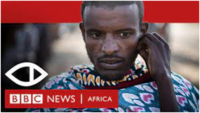Last Updated on May 19, 2022 by themigrationnews

Length: 45 minutes.
Director: Charles Empatz
Production under BBC Africa Eye.
Location: Eastern Africa, Middle East, and Europe.
Language: English.
Year of release: 2021
The Beginning
The documentary starts in a remote part of Eastern African country, the great Ethiopia. Like many other African countries, the area is poverty-ridden due to the ‘African’ disease factors. It can be summarized as war, famine, poor quality of education, discrimination, marginalization, lack of opportunity, and perception of others as superior. As we are introduced to a protagonist Mustafa Jamal, the scene warns all its viewers. He who runs away from home onto the unknown road perishes- indicating the dangers of irregular pathways and illegal border crossings, primarily by individuals from third world countries.
Mustafa Jamal narrates how he was forced to consider a better life in Saudi Arabia due to his traditional homeland North Shewa being infertile. A group of migrants is then introduced in the middle of a desert, an area between the Ethiopian-Djibouti border on an illegal border crossing. They lack water and are forced to carry an injured migrant in the first step of their journey, crossing to a neighboring country. The illegal route is from Ethiopia to Djibouti across the Red Sea to Yemen, while the final destination is Saudi Arabia.
The journey is coordinated by smugglers who oversee a two-thousand-mile journey utilizing a traditional slave route. A group coordinator is the head of the smuggling effort, aided by local managers along the route. Logistics and procurement are the functions of the local managers in their jurisdictions. Thus, like a century ago, a local economy emerges from the modern smuggling route. Several challenges are present in the illegal pathway, including injury, deadly fatigue, arrest by state authorities, and, the worst, being captured by human traffickers.
A background check on the immigrants reveals a background of violence in their regions of origin. A member of the syndicate smuggling organization reveals that the majority of the immigrants on the route are ethnic Oromo. They are forced to migrate due to a perception of discrimination and lack of opportunity owing to tribalism. The irregular pathway in ‘phase two’ is intense and takes up to four days of walking before being driven to a Djibouti coastal area. They are then charged a sum of two hundred and thirty dollars to cross the channel.
The Cost of the Journey
The cost charged by smugglers is excessive and unworthy considering the price of a plane ticket from Ethiopia to Saudi Arabia is quoted at two hundred and thirty-two dollars, being off-peak season (Trip.Com, 2022). As an African seeing an elderly woman, the age of my mother in her fifties lying on the ground dead from exhaustion is a true insult to our institutions, considering the legal air pathway only takes two hours. It does not take a deadly toll on those crossing. Couldn’t the elderly woman have saved money and travelled and worked legally? This question is rendered pointless as the structural conditions that pushed the woman to undertake the perilous path are glossed over.
The question mocks learned individuals in the African continent. Why do our states allow illegal pathways, yet our institutions can back a migrant at the local level? Complemented by international partners such as the European Union and the International Organization of Migration, the illegal pathway will be eradicated through a ‘safe and legal pathway project.’
The third face of the journey mocks even more loudly our African institutions as migrants cross the Red Sea in overcrowded boats. The narrator comments hundreds, if not thousands drown in the crossing to Yemen. A thousand Ethiopians arrive on the coast of Yemen daily, meaning countless are lost at sea. Yet, the appeal of migration persists due to instability, primarily caused by ethnic tensions, and the theme cuts across Sub-Saharan Africa. The migrants are forced to walk or hitch a ride to the Southern City of Aden in Yemen- a country engulfed in civil war, meaning many are lost to jihadist and mafia organizations. Saudi Arabia allied militias and mafias are utilized to prevent an overflow of migrants into the country, a restrictive strategy that complements their local border guard.
Brother vs. Brother vs. Master
Mustafa Jamal, an ethnic Oromo, was held captive by a Tigray mafia in a safe house and tortured for ransom. Ibrahim, an Oromo trafficker, confesses that Saudi Arabia and Yemeni officials utilize the traditional ethnic hatred in Ethiopia to eliminate potential illegal migrants. The Tigray Mafia and Oromo mafia are, therefore, pawns of the country authorities. They are locked in safe houses, and their families are transported back to Ethiopia. Mustafa Jamal and another immigrant are victims and wasted their lives locked up rather than working to improve the global economy.
In the third phase, many are forced to stop their journey in Aden as they are broke and are forced to be slaves to aid organizations such as the refugee rescue committee. The Saudi border, a militarized fortress, is difficult to penetrate, and Mustafa Jamal, trying to enter Saudi, was shot by the border guard. He was hospitalized in Yemen and forced to return to Ethiopia after six months. A repatriation organization was able to help the lad, and he was back in home Abyssinia. His father, for whom Jamal wept for, was glad to see him back home.
Mustafa Jamal’s case is one in a million of desperate individuals seeking employment and a better life in more developed countries. I was saddened by the news of my own countrymen perishing in a boat some kilometers off the coast of Sudan. A boat carrying at least twenty South Sudanese immigrants capsized in the Red Sea while some were saved (Al-monitor, 2021). Political instability, lack of opportunity, and a perception of economic sustainability of irregular pathways are major factors that waste the potential of many African individuals.
Conclusion and Solution
The documentary is one of a kind that has covered the journey of a desperate migrant and shown the challenges of an irregular pathway in its totality. A true firsthand experience of the perilous journey from the country of origin avoiding state authorities to the country of destination. The factors that prompted the use of illegal pathways of migration are analysed very well. The weakness of state authorities and institutions, and volatile economies, are brought out as they push countless to risk their lives despite support from international organizations like the International Organization for Migration and the United Nations, other non-governmental organizations, and private stakeholders. A protagonist like Mohammed Jamal has the ability to save at least five hundred dollars to undertake a journey through a regular pathway. Rather than leaving the country, he should have been able to invest in a local saving cooperative and undertake the journey through a legal pathway. The state, international and local organizations should provide a stimulus for individuals to undertake regular pathways while countering the irregular pathway through an economic stimulus.
‘Refugees will continue to seek asylum. Through existing bilateral agreements, they should access opportunities in the comfort of an efficient and safe regular pathways. End the hell road!’

Benedict Kuol is a finance major graduate from Strathmore University in Nairobi Kenya. He is also a student of Global Compact for Migration and a research Intern at GRDFT India. He is passionate about writing and research and aims to write and publish several books.
